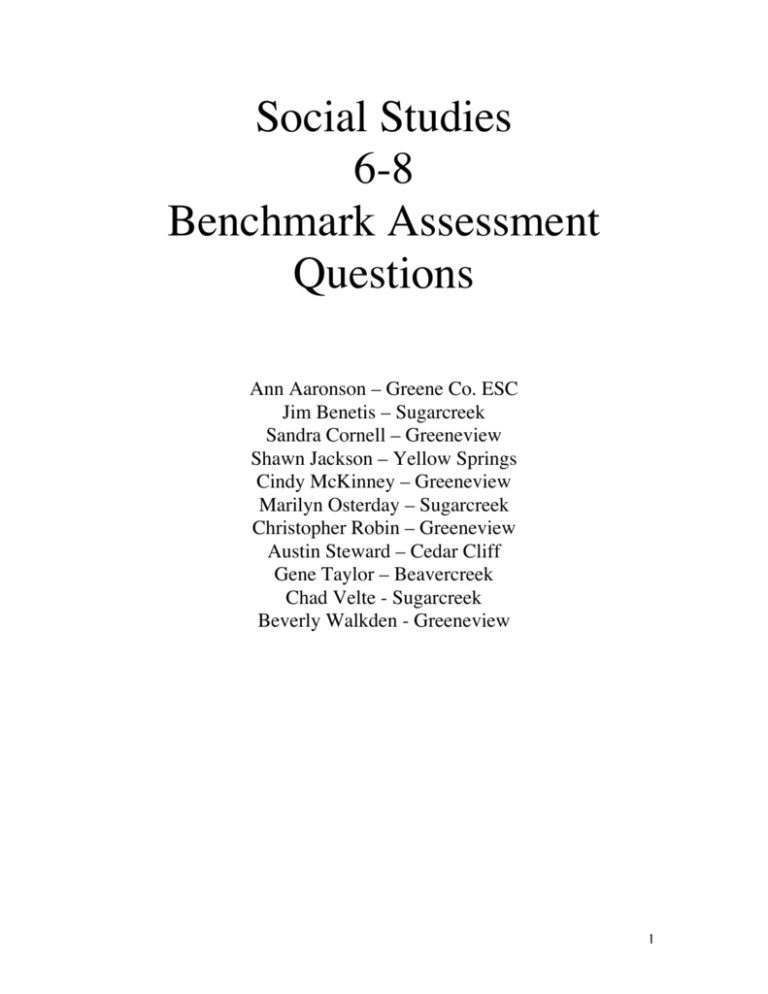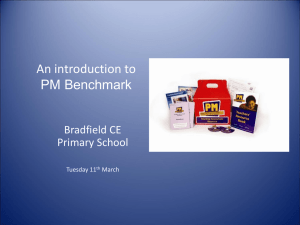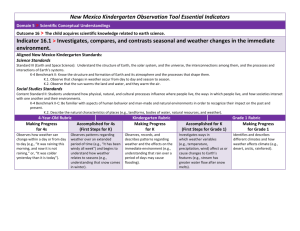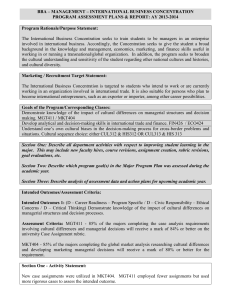History - Greene ESC
advertisement

Social Studies 6-8 Benchmark Assessment Questions Ann Aaronson – Greene Co. ESC Jim Benetis – Sugarcreek Sandra Cornell – Greeneview Shawn Jackson – Yellow Springs Cindy McKinney – Greeneview Marilyn Osterday – Sugarcreek Christopher Robin – Greeneview Austin Steward – Cedar Cliff Gene Taylor – Beavercreek Chad Velte - Sugarcreek Beverly Walkden - Greeneview 1 Social Studies 6-8 History Sample Test Questions Students use materials drawn from the diversity of human experience to analyze and interpret significant events, patterns and themes in the history of Ohio, the United States and the world. Benchmark A Interpret relationships between events shown on multiple-tier time lines. 2 Grade band: 6-8 Subject: Social Studies Benchmark: History A Question type: Multiple Choice Bloom: Comprehension Question: Which is the best conclusion that can be drawn from this information? A. The idea of guaranteeing individual rights developed over time. B. Governments gradually became more abusive. C. Monarchs learned to enjoy sharing power with their subjects. D. The rights of citizens are protected by nobles. Rubric: A 3 Grade band: 6-8 Subject: Social Studies Benchmark: History A Question type: Multiple Choice Bloom: Comprehension Which statement is supported by the information in the timeline? A. All Americans have had the right to vote since the nation was established. B. Very few Americans who have the right to vote do so in national elections. C. The right to vote has been gradually extended. D. Voters today make wiser choices about political candidates. Rubric: D 4 Grade band: 6-8 Subject: Social Studies Benchmark: History A Question type: Short Answer Bloom: Analysis Question: 24th Amendment prohibited poll (voting) taxes 22nd Amendment Placed twoterm limit on presidency 1940 1945 Franklin Delano Roosevelt elected to third term 1950 Harry S. Truman elected Franklin Delano Roosevelt elected to third term Franklin Delano Roosevelt dies in office/V.P. Harry S. Truman becomes President/No Vice President 23rd Amendment granted presidential voting in the District of Columbia 1955 Dweight Eisenhower re-elected Dweight Eisenhower elected 1960 John F. Kennedy elected John F. Kennedy assassinated/ V.P. Lyndon Johnson becomes President/N o Vice President 25th Amendment defined presidential and vice presidential succession because of illness, death or resignation 26th Amendment granted right to vote to 18-year-olds 1965 Richard Nixon elected Lyndon Johnson elected 1970 1975 Richard Nixon Reelected President Richard Nixon resigns/V.P. Gerald Ford becomes President/ Nelson Rockefeller appointed V.P. Vice President Spiro T. Agnew resigns/ Gerald Ford appointed Vice President Choose one amendment that deals with the presidential term of office and name one president who was affected by the amendment. Explain how he was affected. Rubric: The 22nd amendment placed a two-term limit on presidency. Dwight Eisenhower was president at the time and could not run for a third term. 2 points – students identified the 22nd term and each successive president having no more than two terms beginning with Dwight Eisenhower. 1 point – students identified either the president or the 22nd Amendment 0 point – students did not understand the concept of the question. 5 History Benchmark B Describe the political and social characteristics of early civilizations and their enduring impact on later civilizations. 6 Grade band: 6-8 Subject: Social Studies Benchmark: History B Question type: multiple choice Bloom: knowledge Question: Which civilization produced the philosophers Aristotle, Plato, and Socrates? A. Chinese B. Egyptian C. Roman D. Greek Rubric: Greek 7 Grade band: 6-8 Subject: Social Studies Benchmark: History B Question type: extended response Bloom: knowledge and analysis Question: a. Select two pictures, write the number of each picture you selected, and tell what the structure in each picture you selected is called. b. Explain the importance of both structures you selected to the lives of the people who lived in that civilization. Rubric: Naming at least 2 structures for 2 points Parthenon Pyramid Great Wall of China Roman Aqueducts Explaining the importance of each for 2 more points Greek temple dedicated to the goddess Athena Tombs for pharaohs Barrier to keep out Mongols Water control Naming 1 for 1 point Identifying the use of 1 for one point 8 Grade band: 6-8 Subject: Social Studies Bench mark: B Question type: short answer Bloom: comprehension How did learning to produce food lead to developing villages by early civilizations? Give two examples. Rubric: One point for any one of the following; Farming provided a steady food supply. They began to domesticate animals. People no longer needed to hunt and gather food. With more leisure time people began to specialize and depend on one another for goods and services. 9 Grade band: 6-8 Subject: Social Studies Benchmark: History B Question type: short answer Bloom application: application Question: Identify at least two gifts of the Nile that produced the results shown in the paintings. 10 Rubric Possible answers: Irrigation Fertile soil Food Agriculture farming Any one of the these for 1 point. Any two of the three for 2 points. 11 Grade band: 6-8 Subject: Social Studies Benchmark: History B Question type: multiple choice Bloom application: knowledge Question: Which is the best conclusion that can be drawn from this information? a. b. c. d. The idea of guaranteeing individual rights developed over time. Governments gradually became more abusive. Monarchs learned to enjoy sharing power with their subjects. The rights of citizens are protected by nobles. Rubric: The answer is a for one point. 12 History Benchmark C Describe the characteristics of feudal societies and the transition to the Renaissance and Reformation in Europe. 13 Grade Band: 6-8 Subject: Social Studies Benchmark: History—C Question type: Multiple Choice Bloom: knowledge Question: In the Chinese feudal system, the role of the nobility was to A. collect money from the landowners. B. own the land and supervise the work. C. farm and pay for the use of the land. Rubric: B 14 Grade band: 6-8 Subject: Social Studies Benchmark: History C Question type: multiple choice Bloom: Knowledge Question: The Renaissance began in the city-states of A. France B. Italy C. Greece D. England Rubric: B 15 Grade band: 6-8 Subject: Social Studies Benchmark: History C Question type: Short Answer Bloom: Comprehension Question: Renaissance and Reformation The years AD 1350-1600 were a time of new ideas in government, art, scholarship, and religion. The outline below list five cultural areas in which innovations, as well as rediscoveries of techniques which had fallen into disuse, occurred. Under the heading, “painting” writes the innovations and rediscoveries, selecting from the following list. • • • • • • Petrarch introduced sonnets Architects substituted domes and columns for medieval arches and spires Artists created lifelike, freestanding statures of nude figures in bronze and marble Humanists wrote in everyday languages rather than Latin. Using new techniques, artists made paintings more lifelike. Artists made enormous statues. • • • • • Architects adorned buildings with tapestries, paintings, and statues. Protestantism was born as a result of Luther’s conflicts with the Catholic Church. With a new method of printing, books became more widely available. Northern European painters developed the technique of painting in oils. The Catholic Reformation began in reaction to spread of Protestantism. Rubric: Using new techniques, artists made paintings more lifelike. Northern European painters developed the technique of painting in oils. 2 points – Students identified the two points above 1 point – Students identified one point from above 0 point – Students demonstrated no understanding of the question 16 Grade band: 6-8 Subject: Social Studies Benchmark: History C Question type: Extended Response Bloom: Comprehension Question: List four ways how the Chinese Feudal System worked. Rubric: • Nobles owned the land and controlled the land • Peasants/ farmers/ serfs worked the land • Peasants/ farmers paid the (tax) nobles for the use of the land. • Nobles paid the King a part or part of the farmers crop or what was produced • Nobles also supplies or promised to sent the King soldiers in times of War • Feudal states each had to own government 4 points – Students listed four ways the feudal system worked in China 3 points – Students listed three ways the feudal system worked in China 2 points – Students listed two ways the feudal system worked in China 1 point – Students listed one way the feudal system worked in China 0 point – Students did not list any ideas or did not understand how the feudal system worked. 17 History Benchmark D Describe the effects of interactions among civilizations during the 14th through the 18th centuries. 18 Grade band: 6-8 Subject: Social Studies Benchmark: History D Question type: multiple choice Bloom: knowledge Question: Use the map to answer the following question. Which if the areas on the map was the center of Inca civilization? a, J b. K c, L d. M Rubric: Answer is d for one point. 19 Grade band: 6-8 Subject: Social Studies Benchmark: History D Question type: multiple choice Bloom: knowledge Question: The Maya, Aztec, and Inca civilizations each developed a. powerful seafaring traditions. b. monotheistic religious systems. c. democratic governments. d. complex architectural structures. Rubric: The answer is d for one point. 20 History Benchmark E Explain the causes and consequences of the American Revolution, with emphasis on both Colonial and British perspectives. 21 Grade band: 6-8 Subject: Social Studies Benchmark: History E Question type: multiple choice Bloom: knowledge Question: As a result of the Revolutionary War, the British agreed to a. recognize the United States as a British colony. b. recognize the United States as a free and independent nation. c. allow Americans to have representatives in Parliament. d. seek new allies against the United States. Rubric: The answer is b for one point. 22 Grade band: 6-8 Subject: Social Studies Benchmark: History E Question type: extended response Bloom: evaluation Question: During the American Revolution the British had several advantages such as a superior army and navy. Describe what advantages the colonists had during the American Revolution. Please support your answer. Rubric: One point for each listed suggested up to 4 points. 1. Colonist was fighting at home. 2, they used their own tactics. 3. Their cause was well supported. 4, they had help from other countries. 5. They wanted their own government. 6. They wanted to be free of British rule. 7. They had more reserves. 23 Grade band: 6-8 Subject: Social Studies Benchmark: History E Question type: short answer Bloom: synthesis Question: Explain how African Americans contributed to the American Revolution for both the British and the colonist. Rubric: One point for each of the following up to 4 points. They served in both the British and Colonial Armies.. The British offered freedom. The first person to die was an African American. 24 History Benchmark F Explain the political and economic challenges faced by the United States after the Revolutionary War and the actions that resulted in the adoption of the U.S. Constitution. 25 Grade band: 6-8 Subject: Social Studies Benchmark: History F Question type: multiple choice Bloom: knowledge Question: Which of these would complete the diagram? a. Alien and Sedition Acts b. U.S. Constitution c. Magna Carta d. Declaration of Independence Rubric: Answer is b for one point. 26 Grade band: 6-8 Subject: Social Studies Benchmark: History F Question type: multiple choice Bloom: knowledge Question: Anti-Federalists had many of their concerns about the U.S. Constitution satisfied through the approval of the a. Bill of Rights b. Electoral college c. Three-Fifths Compromise d. Treaty of Paris Rubric: B 27 Grade band: 6-8 Subject: Social Studies Benchmark: History F Question type: multiple choice Bloom: knowledge Question: Alexander Hamilton favored a strong federal government because he believed it would benefit the economy. As a result of this belief, he also supported a. b. c. d. the abolishment of all tariffs the establishment of a national bank increasing agricultural activity imposing high taxes on factories Rubric: The answer is b for one point. 28 Grade band: 6-8 Subject: Social Studies Benchmark: History F Question type: short answer Bloom: comprehension Question: Describe the result of southern states wanting enslaved persons counted for representation but not taxation during the Constitutional Convention. Rubric: One point for each of the following up to a total of two points. 3/5 Compromise Southern states wanted lower taxes. Southern states wanted more representation in Congress. 29 History Benchmark G Analyze the causes and consequences of the American Civil War. 30 Grade band: 6-8 Subject: Social Studies Benchmark: History G Question type: multiple choice Bloom: knowledge Question: What agricultural invention, designed to increase production, had the effect of increasing the number of slaves needed for labor in the Deep South? a. b. c. d. the wheat reaper the cotton gin the steel plow the rice mill Rubric: The answer is b for 1 point. 31 Grade band: 6-8 Subject: Social Studies Benchmark: History G Question type: extended response Bloom: synthesis Question: Compile a list of people who might be affected by this poster. Why would these people need to be warned? Rubric: Possible answers are; - 1 point for each of the following; fugitive slaves runaway slaves colored people of Boston Fugitive slaves were treated as “lost property” and could be captured and returned to their owners. Local watchmen and police officers were empowered to assist slave catchers. 32 Grade band: 6 – 8 Subject: Social Studies Benchmark: G Question type: multiple choice Bloom: knowledge Question: These people served as public officials during the Civil War. Which of the following matches is incorrect? a. Jefferson Davis – secretary of state for the Confederacy b. Ulysses S. Grant – commander of the Union army c. Robert E. Lee – commander of the Confederate army d. Abraham Lincoln – president of the United States Rubric: The answer is a for one point. 33 Grade band: 6 – 8 Subject: Social Studies Benchmark: G Question type: short answer Bloom: comprehension Question: Describe two violent incidents that showed that the nation was moving from peaceful compromise toward violence. Rubric: One point for each of the following; John Browns raid Bleeding Kansas Attack in the Senate Threats Attack on Fort Sumter Abolitionist 34







